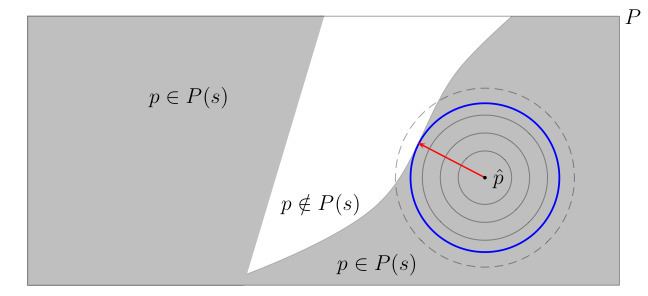 | ||
The stability radius of an object (system, function, matrix, parameter) at a given nominal point is the radius of the largest ball, centered at the nominal point, all of whose elements satisfy pre-determined stability conditions. The picture of this intuitive notion is this:
Contents
- Abstract definition
- History
- Relation to Walds maximin model
- Info gap decision theory
- Variations on a theme
- Stability radius of functions
- Definition
- Applications
- Properties
- Examples
- References
where
Abstract definition
The formal definition of this concept varies, depending on the application area. The following abstract definition is quite useful
where
History
It looks like the concept was invented in the early 1960s. In the 1980s it became popular in control theory and optimization. It is widely used as a model of local robustness against small perturbations in a given nominal value of the object of interest.
Relation to Wald's maximin model
It was shown that the stability radius model is an instance of Wald's maximin model. That is,
where
The large penalty (
Info-gap decision theory
Info-gap decision theory is a recent non-probabilistic decision theory. It is claimed to be radically different from all current theories of decision under uncertainty. But it has been shown that its robustness model, namely
is actually a stability radius model characterized by a simple stability requirement of the form
Since stability radius models are designed to deal with small perturbations in the nominal value of a parameter, info-gap's robustness model measures the local robustness of decisions in the neighborhood of the estimate
Sniedovich argues that for this reason the theory is unsuitable for the treatment of severe uncertainty characterized by a poor estimate and a vast uncertainty space.
Variations on a theme
There are cases where it is more convenient to define the stability radius slightly different. For example, in many applications in control theory the radius of stability is defined as the size of the smallest destabilizing perturbation in the nominal value of the parameter of interest. The picture is this:
More formally,
where
Stability radius of functions
The stability radius of a continuous function f (in a functional space F) with respect to an open stability domain D is the distance between f and the set of unstable functions (with respect to D). We say that a function is stable with respect to D if its spectrum is in D. Here, the notion of spectrum is defined on a case by case basis, as explained below.
Definition
Formally, if we denote the set of stable functions by S(D) and the stability radius by r(f,D), then:
where C is a subset of F.
Note that if f is already unstable (with respect to D), then r(f,D)=0 (as long as C contains zero).
Applications
The notion of stability radius is generally applied to special functions as polynomials (the spectrum is then the roots) and matrices (the spectrum is the eigenvalues). The case where C is a proper subset of F permits us to consider structured perturbations (e.g. for a matrix, we could only need perturbations on the last row). It is an interesting measure of robustness, for example in control theory.
Properties
Let f be a (complex) polynomial of degree n, C=F be the set of polynomials of degree less than (or equal to) n (which we identify here with the set
where q contains each basis vector (e.g.
